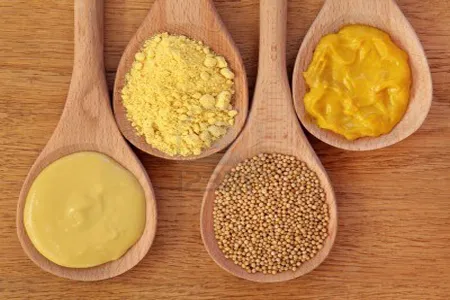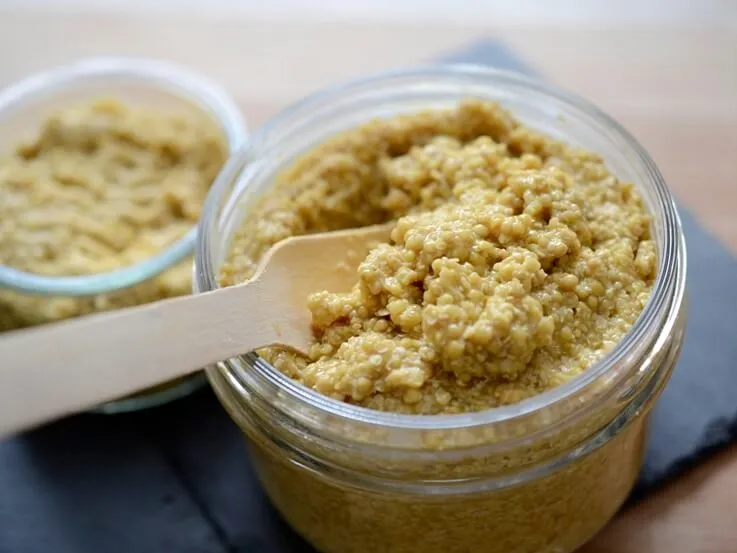It's Saturday, we are already on the 5th of August. I have a growing discomfort due to the amount of sneezing and the discomfort typical of the flu. The weather is raining, that doesn't help me feel better, and it doesn't help with the stability of the electrical service supply either, but you do what you can with what you have in #life, and we move on.
I'm not going to comment much, because the risk of running out of electricity in minutes is serious, so let's go directly to comment on the #History ephemeris for today, which gives me the title for the publication. Today, because it is the first Saturday of August, is 'Mustard Day', a date proposed in 1991 by the Mustard Museum, and was celebrated that year in Mount Horeb, Wisconsin (United States).
+++
I'm not going to comment much, because the risk of running out of electricity in minutes is serious, so let's go directly to comment on the #History ephemeris for today, which gives me the title for the publication. Today, because it is the first Saturday of August, is 'Mustard Day', a date proposed in 1991 by the Mustard Museum, and was celebrated that year in Mount Horeb, Wisconsin (United States).
+++
Es sábado, ya estamos en el día 5 del mes de agosto. Tengo un malestar creciente por la cantidad de estornudos y las molestias propias de la gripe. El clima está de lluvia, eso no me ayuda a sentirme mejor y tampoco ayuda con la estabilidad del suministro del servicio eléctrico, pero se hace lo que se puede con lo que se tiene en la #vida y seguimos adelante.
No voy a comentar mucho, porque el riesgo de quedarme sin electricidad en minutos es serio, así que pasemos directamente a comentar sobre la efeméride de la #Historia para hoy, que me da el título para la publicación. Hoy, por ser el primer sábado del mes de agosto, es el ‘Día de la Mostaza’, una fecha propuesta en 1991 por el Museo de la Mostaza, y se celebró en ese año en Mount Horeb, Wisconsin (Estados Unidos).
+++
No voy a comentar mucho, porque el riesgo de quedarme sin electricidad en minutos es serio, así que pasemos directamente a comentar sobre la efeméride de la #Historia para hoy, que me da el título para la publicación. Hoy, por ser el primer sábado del mes de agosto, es el ‘Día de la Mostaza’, una fecha propuesta en 1991 por el Museo de la Mostaza, y se celebró en ese año en Mount Horeb, Wisconsin (Estados Unidos).
+++

Image's Source - Fuente de la Imagen
The #mustard seed has a high symbolic importance in Christian religiosity, as far as I remember, by comparing the faith of people with small #seeds that, despite their humble and small size, have the potential to become a great plant, bear fruit and propagate.
I think I'm going to publish this piece of the post first and then update the content, it's just as a temporary measure in case I get disconnected or lose power, so I don't leave the day without my daily log. I hope to be able to complete it in a short time.
+++
I think I'm going to publish this piece of the post first and then update the content, it's just as a temporary measure in case I get disconnected or lose power, so I don't leave the day without my daily log. I hope to be able to complete it in a short time.
+++
La semilla de #mostaza tiene una alta importancia simbólica en la religiosidad cristiana, hasta donde recuerdo, por la comparación de la fe de las personas con pequeñas #semillas que, a pesar de su humilde y pequeño tamaño, tienen el potencial de convertirse en una gran planta, brindar frutos y propagarse.
Creo que voy a ir publicando este trozo del post primero y luego actualizo el contenido, es solo como una medida temporal en caso de que me saquen de línea o me quede sin electricidad, para no dejar el día sin mi registro diario. Espero poder completarlo en breve tiempo.
+++
Creo que voy a ir publicando este trozo del post primero y luego actualizo el contenido, es solo como una medida temporal en caso de que me saquen de línea o me quede sin electricidad, para no dejar el día sin mi registro diario. Espero poder completarlo en breve tiempo.
+++

Image's Source - Fuente de la Imagen
Editing:
Ok, I managed to post the earlier segment, so I'm writing this later part a little more slowly, plus it took a while to write, edit, and delete parts I've written. There are days when I'm not very satisfied with my content writing, but I think I'm already heading towards where I want to take the post.
By the way, I had mentioned the Mustard Museum, but I forgot to put the link of this institution for the celebration of this day, which is: https://mustardmuseum.org/mustard-day/
As for the origin of the mustard itself, it turns out that there are references to this species in the Indian subcontinent that go back approximately 3,700 years into the past, and those are the most moderate archaeological estimates, since there are those who point out that there are reliefs in temples of (supposedly) greater antiquity that point to the domestication of this #plant long before what was thought.
+++
Ok, I managed to post the earlier segment, so I'm writing this later part a little more slowly, plus it took a while to write, edit, and delete parts I've written. There are days when I'm not very satisfied with my content writing, but I think I'm already heading towards where I want to take the post.
By the way, I had mentioned the Mustard Museum, but I forgot to put the link of this institution for the celebration of this day, which is: https://mustardmuseum.org/mustard-day/
As for the origin of the mustard itself, it turns out that there are references to this species in the Indian subcontinent that go back approximately 3,700 years into the past, and those are the most moderate archaeological estimates, since there are those who point out that there are reliefs in temples of (supposedly) greater antiquity that point to the domestication of this #plant long before what was thought.
+++
Edición:
Bien, logré publicar el segmento anterior, así que esta parte posterior la estoy escribiendo con un poco más de calma, además de que llevó un rato escribiendo, editando y borrando partes que he escrito. Hay días en que no estoy muy conforme con mi redacción de contenidos, pero creo que voy ya encaminado hacia donde quiero llevar el post.
Por cierto, había mencionado al Museo de la Mostaza, pero olvidé colocar el enlace de esta institución para la celebración de este día, que es: https://mustardmuseum.org/mustard-day/
En cuanto al origen de la mostaza en sí, pues resulta que hay referencias de esta especie en el subcontinente indio que se remontan aproximadamente a unos 3700 años hacia el pasado, y esas son las estimaciones arqueológicas más moderadas, pues hay quienes señalan que hay relieves en templos de (supuestamente) mayor antigüedad que apuntan a la domesticación de esta #planta mucho tiempo antes de lo que se pensaba.
+++
Bien, logré publicar el segmento anterior, así que esta parte posterior la estoy escribiendo con un poco más de calma, además de que llevó un rato escribiendo, editando y borrando partes que he escrito. Hay días en que no estoy muy conforme con mi redacción de contenidos, pero creo que voy ya encaminado hacia donde quiero llevar el post.
Por cierto, había mencionado al Museo de la Mostaza, pero olvidé colocar el enlace de esta institución para la celebración de este día, que es: https://mustardmuseum.org/mustard-day/
En cuanto al origen de la mostaza en sí, pues resulta que hay referencias de esta especie en el subcontinente indio que se remontan aproximadamente a unos 3700 años hacia el pasado, y esas son las estimaciones arqueológicas más moderadas, pues hay quienes señalan que hay relieves en templos de (supuestamente) mayor antigüedad que apuntan a la domesticación de esta #planta mucho tiempo antes de lo que se pensaba.
+++

Image's Source - Fuente de la Imagen
However, it seems that the leaves of the plant were most consumed, the processing of the seeds, to create the pasty and sweet and sour cream, seems to have originated in China, during the Zhou Dynasty, which dates back about 1000 years before our common era. But that Asian preparation would not be so familiar to us, the closest antecedent we have to the condiment that we know in the West, I think we owe it to the Romans, who mixed the ground seed with grape must, hence the Latin name of this #condiment referred to 'Most' (grape) 'Ardent', with which, in our language, over the centuries, we came to name it Mustard.
The use of mustard was not limited to serving as a condiment in #gastronomy, whether in India, China, Greece or Rome; but it was also used in herbal pharmacology, partly due to the old idea that 'your medicine is your food, your food is your medicine' that these ancient civilizations promulgated in one way or another.
+++
The use of mustard was not limited to serving as a condiment in #gastronomy, whether in India, China, Greece or Rome; but it was also used in herbal pharmacology, partly due to the old idea that 'your medicine is your food, your food is your medicine' that these ancient civilizations promulgated in one way or another.
+++
Sin embargo, parece que lo que más se consumía eran las hojas de la planta, el procesamiento de las semillas, para crear la crema pastosa y agridulce, parece que se originó en China, durante la Dinastía Zhou, la cual se remonta a unos 1000 años antes de nuestra era común. Pero esa preparación asiática no nos resultaría tan familiar, el antecedente más cercano que tenemos al condimento que conocemos en occidente, creo que se lo debemos a los romanos, que mezclaron la semilla molida a mosto de uva, de allí que el nombre en latín de este condimento hiciera referencia a ‘Mosto’ (de uva) ‘Ardiente’, con lo que, en nuestro idioma, con el pasar de los siglos, llegamos a nombrarle Mostaza.
El uso de la mostaza no estaba limitado a servir de condimento en la gastronomía, ya fuera en la India, en China, Grecia o Roma; sino que también se empleaba en farmacología herbolaria, en parte por la vieja idea de que ‘tu medicina es tu comida, tu comida es tu medicina’ que promulgaban de una o de otra manera estas civilizaciones antiguas.
+++
El uso de la mostaza no estaba limitado a servir de condimento en la gastronomía, ya fuera en la India, en China, Grecia o Roma; sino que también se empleaba en farmacología herbolaria, en parte por la vieja idea de que ‘tu medicina es tu comida, tu comida es tu medicina’ que promulgaban de una o de otra manera estas civilizaciones antiguas.
+++

Image's Source - Fuente de la Imagen
In the case of Europe, after the fall of the Roman Empire, and the beginning of the Middle Ages, there are records of the production in the territory of Dijon (France) and part of Italy, of particular mustard recipes since the 17th century. XIII, which for those who cook, will surely still be familiar to them, since 'Dijon mustard' is still produced today. By the way, I did not find that the Italian recipe survived independently after the Middle Ages, it seems that the continuous rises and falls of the kingdoms and empires ended up erasing that contribution, or it was adsorbed by the mustard preparation recipe from other places.
Moving forward to the 19th century, we have that the British, with their Industrial Revolution process, also tackled the production and processing of food in large quantities, that included mustard as a condiment and led to its industrialization, and also to its international commercialization on a large scale. However, the recipe that I think is most successful in the Western Hemisphere turns out to be the American one, made at the beginning of the 20th century (1904) and marketed by George T. French.
+++
Moving forward to the 19th century, we have that the British, with their Industrial Revolution process, also tackled the production and processing of food in large quantities, that included mustard as a condiment and led to its industrialization, and also to its international commercialization on a large scale. However, the recipe that I think is most successful in the Western Hemisphere turns out to be the American one, made at the beginning of the 20th century (1904) and marketed by George T. French.
+++
En el caso de Europa, luego de la caída del Imperio Romano, y los inicios de la Edad Media, se tienen registros de la producción en el territorio de Dijon (Francia) y parte de Italia, de unas recetas particulares de mostaza desde el siglo XIII, que para quienes cocinen, de seguro que aún les resultará familiar, pues la ‘Mostaza Dijon’ aún se produce en la actualidad. Por cierto, que no encontré que la receta italiana sobreviviera de manera independiente luego del medioevo, parece que los continuos auges y caídas de los reinos e imperios terminó por borrar ese aporte o fue adsorbido por la receta de preparación de mostaza de otras partes.
Avanzando hasta el siglo XIX, tenemos que los británicos, con su proceso de Revolución Industrial, también abordaron la producción y procesamiento de comida en grandes cantidades, eso incluyó la mostaza como condimento y llevó a su industrialización, y también a su comercialización internacional a gran escala. Sin embargo, la receta que creo que es más exitosa en el hemisferio occidental, resulta ser la norteamericana, elaborada en los inicios del siglo XX (1904) y comercializada por George T. French.
+++
Avanzando hasta el siglo XIX, tenemos que los británicos, con su proceso de Revolución Industrial, también abordaron la producción y procesamiento de comida en grandes cantidades, eso incluyó la mostaza como condimento y llevó a su industrialización, y también a su comercialización internacional a gran escala. Sin embargo, la receta que creo que es más exitosa en el hemisferio occidental, resulta ser la norteamericana, elaborada en los inicios del siglo XX (1904) y comercializada por George T. French.
+++

Image's Source - Fuente de la Imagen
French's recipe had a very strong and intense yellow color, due to the addition of Turmeric as a seasoning in the oily base mixture, into which he mixed and stabilized his mustard. The success in his country of this mustard recipe was largely due to two particular things, these things were the 'Hot-Dog' as a fast-food snack, and Baseball as a national sport; but this part of the story is quite long and would merit a separate publication. Suffice it to point out that it was almost engraved in the collective memory that: (1) mustard was the mandatory condiment on sausages, and that (2) this dish (the #Hotdog) was eaten in stadiums while enjoying sporting events of the #Baseball.
+++
+++
La receta de French tenía un muy fuerte e intenso color amarillo, debido a la adición de cúrcuma como condimento en la mezcla de base aceitosa en la que mezclaba y estabilizaba su mostaza. El éxito en su país de esta receta de mostaza se debió en buena medida a dos cosas particulares, estas cosas fueron el ‘Hot-Dog’ como bocadillo de #comida rápida, y el Beisbol como deporte nacional; pero esta parte de la historia es bastante larga y ameritaría una publicación independiente. Baste señalar que, quedó casi grabado en la memoria colectiva que: (1) la mostaza era el condimento obligativo sobre las salchichas, y que (2) se comía este platillo (el Hotdog) en los estadios mientras se disfrutaba de los encuentros deportivos de #Beisbol.
+++
+++

Image's Source - Fuente de la Imagen
Well, I think that now, if I have completed what I wanted to share about today's celebration, I say goodbye, wishing you that you are well and that we can read each other again another time.
+++
+++
Bien, creo que ahora, si he completado lo que quería compartir acerca de la celebración de hoy, ya me despido, deseándote que tú estés bien y que nos podamos leer de nuevo en otra oportunidad.
+++
+++

This post, on the #blockchain #Hive, is in the We Are Alive Tribe community, it's part of the #IAmAliveChallenge
This challenge is an initiative of @flaxz
The 4 points to join the #IAmAliveChallenge, includes using the hashtag #alive to post to We Are Alive Tribe and earn ALIVE tokens.
This challenge is an initiative of @flaxz
The 4 points to join the #IAmAliveChallenge, includes using the hashtag #alive to post to We Are Alive Tribe and earn ALIVE tokens.
Esta publicación, en la #blockchain #Hive, está en la comunidad We Are Alive Tribe, es parte del #IAmAliveChallenge
Este desafío es iniciativa de @flaxz
Los 4 puntos para unirte al #IAmAliveChallenge, incluyen el uso de la etiqueta #alive para publicar en We Are Alive Tribe y ganar tokens ALIVE.
Este desafío es iniciativa de @flaxz
Los 4 puntos para unirte al #IAmAliveChallenge, incluyen el uso de la etiqueta #alive para publicar en We Are Alive Tribe y ganar tokens ALIVE.
